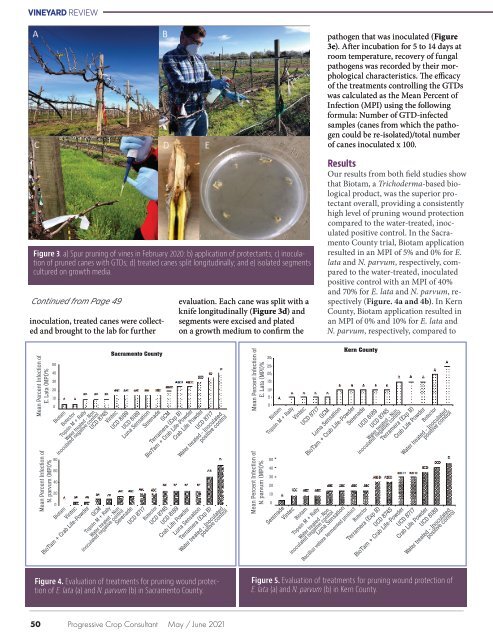Progressive Crop Consultant May/June 2021
Create successful ePaper yourself
Turn your PDF publications into a flip-book with our unique Google optimized e-Paper software.
VINEYARD REVIEW<br />
pathogen that was inoculated (Figure<br />
3e). After incubation for 5 to 14 days at<br />
room temperature, recovery of fungal<br />
pathogens was recorded by their morphological<br />
characteristics. The efficacy<br />
of the treatments controlling the GTDs<br />
was calculated as the Mean Percent of<br />
Infection (MPI) using the following<br />
formula: Number of GTD-infected<br />
samples (canes from which the pathogen<br />
could be re-isolated)/total number<br />
of canes inoculated x 100.<br />
Figure 3. a) Spur pruning of vines in February 2020: b) application of protectants; c) inoculation<br />
of pruned canes with GTDs; d) treated canes split longitudinally; and e) isolated segments<br />
cultured on growth media.<br />
Continued from Page 49<br />
inoculation, treated canes were collected<br />
and brought to the lab for further<br />
evaluation. Each cane was split with a<br />
knife longitudinally (Figure 3d) and<br />
segments were excised and plated<br />
on a growth medium to confirm the<br />
Results<br />
Our results from both field studies show<br />
that Biotam, a Trichoderma-based biological<br />
product, was the superior protectant<br />
overall, providing a consistently<br />
high level of pruning wound protection<br />
compared to the water-treated, inoculated<br />
positive control. In the Sacramento<br />
County trial, Biotam application<br />
resulted in an MPI of 5% and 0% for E.<br />
lata and N. parvum, respectively, compared<br />
to the water-treated, inoculated<br />
positive control with an MPI of 40%<br />
and 70% for E. lata and N. parvum, respectively<br />
(Figure. 4a and 4b). In Kern<br />
County, Biotam application resulted in<br />
an MPI of 0% and 10% for E. lata and<br />
N. parvum, respectively, compared to<br />
Mean Percent Infection of<br />
E. Lata (MPI)%<br />
Mean Percent Infection of<br />
N. parvum (MPI)%<br />
50<br />
40<br />
30<br />
20<br />
10<br />
0<br />
80<br />
60<br />
40<br />
20<br />
0<br />
Biotam<br />
Botector<br />
Topsin M + Rally<br />
Water treated - Non<br />
inoculated negative control<br />
Biotam<br />
Vintec<br />
BioTam + Crab Life-Powder<br />
GCM<br />
Sacramento County<br />
UCD 8745<br />
Vintec<br />
UCD 8189<br />
Topsin M + Rally<br />
Water treated - Non<br />
inoculated negative control<br />
UCD 8189<br />
Luna Sensation<br />
Serenade<br />
UCD 8717<br />
Botector<br />
Serenade<br />
GCM<br />
Terramera (Exp B)<br />
BioTam + Crab Life-Powder<br />
Crab Powder<br />
UCD 8717<br />
Water treated - Inoculated<br />
positive control<br />
UCD 8745<br />
UCD 8189<br />
Crab Life Powder<br />
Luna Sensation<br />
Terramera (Exp B)<br />
Water treated - Inoculated<br />
positive control<br />
Mean Percent Infection of<br />
E. Lata (MPI)%<br />
Mean Percent Infection of<br />
N. parvum (MPI)%<br />
30<br />
25<br />
20<br />
15<br />
10<br />
5<br />
0<br />
Biotam<br />
Topsin M + Rally<br />
50<br />
40<br />
30<br />
20<br />
10<br />
0<br />
Serenade<br />
Vintec<br />
Biotam<br />
Topsin M + Rally<br />
Water treated - Non<br />
inoculated negative control<br />
Kern County<br />
Vintec<br />
UCD 8717<br />
GCM<br />
Luna Sensation<br />
BioTam + Crab Life-Powder<br />
Serenade<br />
UCD 8189<br />
UCD 8745<br />
Luna Sensation<br />
Bacillus veleze fermented product<br />
Botector<br />
Water treated - Non<br />
inoculated negative control<br />
Terramera (Exp B)<br />
Crab Life Powder<br />
Botector<br />
Water treated - Inoculated<br />
positive control<br />
Terramera (Exp B)<br />
UCD 8745<br />
BioTam + Crab Life-Powder<br />
UCD 8717<br />
Crab Life Powder<br />
UCD 8189<br />
Water treated - Inoculated<br />
positive control<br />
Figure 4. Evaluation of treatments for pruning wound protection<br />
of E. lata (a) and N. parvum (b) in Sacramento County.<br />
Figure 5. Evaluation of treatments for pruning wound protection of<br />
E. lata (a) and N. parvum (b) in Kern County.<br />
50 <strong>Progressive</strong> <strong>Crop</strong> <strong>Consultant</strong> <strong>May</strong> / <strong>June</strong> <strong>2021</strong>


















